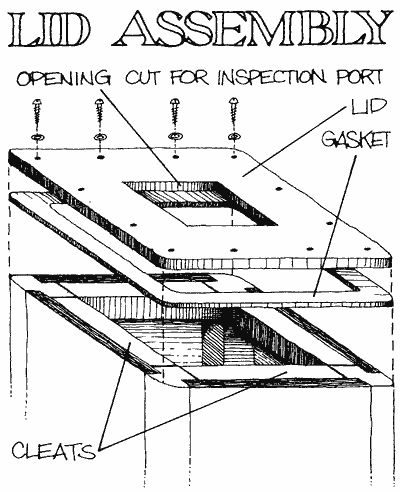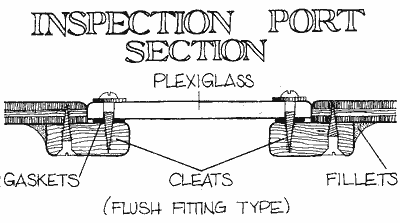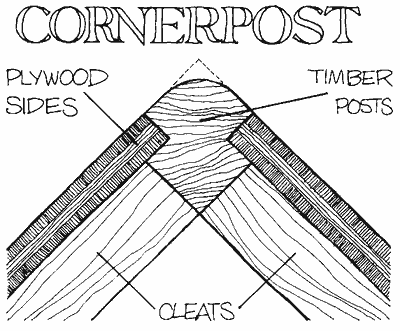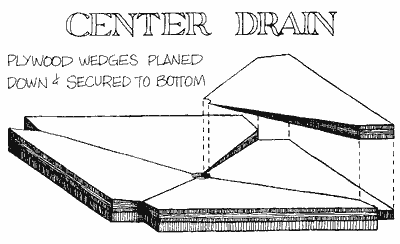Plywood and Epoxy Tanks
by Paul Butler
illustrations by Marya Butler
We've often needed accessory tankage in our boats for drinking water, storage, holding tanks, water ballast, etc. We had many odd-shaped nooks and crannies that we felt might be put to better use than hiding places for the cat.
Along the way we experimented with a variety of available tank configurations and materials. I think we tried them all; galvanized, copper, stainless steel, fiberglass, plastic, and rubber. Many had definite advantages, but none offered the low cost, availability, adaptability, or custom features we wanted.
Building cold-molded boats, we naturally turned to epoxy and wood as a possible alternative. We began experimenting with plywood and epoxy tanks for fuel and water and found acceptable solutions to most of the problems. Unlike metalwork, which is outside our experience, these tanks could be built with familiar woodworking tools and procedures. Tanks were often built of scrap plywood, smaller pieces left over from other projects. We could build a tank to fit any area — deep in the bilge or into a galley top, for example. They were lighter than other types in many cases, and always less expensive. No electrolysis problems. No after-taste when used for water. Portable. They could be customized for the application; thick- or thin- walled, baffled, vented, and drained accordingly.
We constructed smaller tanks of 3/8 inch and 1/2 inch ply, exterior or marine grades. We made some small water tanks of 1/8 inch mahogany door skins, sheathed in side and out with fiberglass cloth and strengthened with corner posts. They were tall and narrow (one fit into a hanging locker); they were lightweight and worked perfectly.
All tanks were sheathed with at least six-ounce cloth and epoxy; sometimes eight- or ten-ounce. We used cleats top and bottom with the corner posts to provide adequate fastening surface. All fastenings were silicone bronze screws, although galvanized would work as well where the screws are encapsulated. All screw heads were countersunk and plugged, or sealed with a mixture of epoxy
and microballoons.

All interior surfaces, posts, cleats, baffles, and the like, were rolled or brushed with not less than three coats of epoxy if they were not sheathed. Drains and high-stress areas such as baffles were additionally filleted with a mixture of microballoons, silica, and epoxy. Fillets were formed with a bottle top or rubber-gloved fingers. Baffles were screwed to appropriately located cleats. All plywood edge grain was sealed with epoxy.
Exterior surfaces were usually sheathed for appearance and strength, especially in the larger sizes — but not always. Most were finished bright. Surfaces exposed to sunlight were finished with varnish over the epoxy as a sunscreen. Sometimes we made galley water tanks to match over-head cabinetry, and provided a gravity flow.
Large, flat tanks with considerable "slosh" needed baffles. The more surface area the liquid has, the more baffles the tank will need. Some were made removable for easier cleanup and inspection.

Inspection plates are handy, even necessary, for repair, cleaning, and attaching hardware. We make the plates big enough for an arm, and in some cases, head and shoulders. The plates can be flush fitting and secured in place with a gasket or non-reactive silicone seal. On smaller tanks, they may be a simple square or round of plywood fitted over a hole and screwed in place. Application dictates construction. Obviously, one takes extraordinary care with a large tank, where leakage may lead to disaster, but a smaller tank may be less critical. On a galley-top tank, we made one side of plexiglass, allowing constant inspection of level and clarity. It would have been a good goldfish
tank.

All the corner posts were made with table saw and router. Any wood that will take and hold a fastening well will do; Oak, Iroko, Fir. We used Philippine Mahogany most of all — real Philippine, not the Luan or Cedar types that are sold as Mahogany. Cut the radius [if you need a radius] with a carbide bit in a router or do it by hand. A steel bit will dull and burn the wood.
The tank's sides are laid out and fitted to the corner posts for a trial run. Then the cleats are added for top and bottom support. The tank is set in place for fill, drain, and vent consideration.

Draining, filling, and venting vary widely according to application. We often used plastic and bronze through-hull fittings. Some people prefer the drain elevated above the bottom of the tank to allow sediment to settle to the bottom. Others want a drain that leaves nothing inside the tank. For emptying drains (and shower stalls) we fitted 3/4 or 1 inch plywood to the bottom, marked the drain location, and cut from each corner to the center of the drain. We then planed and sanded the pie-shaped pieces to a wedge shape and reinstalled them. Fastened in place and faired with microballoons, the drains drained.

Epoxy resins, unlike polyesters, do not absorb water. They are approved by the FDA for food handling surfaces. Before final assembly, we always scrubbed the inside surfaces of each tank with soap and water and then rinsed well. We used two of the plywood tanks for ready water in the galley of our five-ton sailboat and had no problem with aftertaste. We did have a taste problem with a clients boat once, and scrubbed it out with baking soda, then hot water — no more aftertaste.
![]()